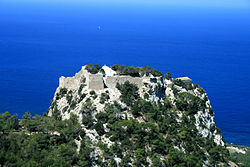




A monolith is a geological feature consisting of a single massive stone or rock, such as some mountains. Erosion usually exposes the geological formations, which are often made of very hard and solid igneous or metamorphic rock. Some monoliths are volcanic plugs, solidified lava filling the vent of an extinct volcano.
Contents
- Geological monoliths
- Africa
- Antarctica
- Asia
- Australia
- Europe
- North America
- South America
- Outside Earth
- Monumental monoliths
- See also
- References
- External links
In architecture, the term has considerable overlap with megalith, which is normally used for prehistory, and may be used in the contexts of rock-cut architecture that remains attached to solid rock, as in monolithic church, or for exceptionally large stones such as obelisks, statues, monolithic columns or large architraves, that may have been moved a considerable distance after quarrying. It may also be used of large glacial erratics moved by natural forces.
The word derives, via the Latin monolithus, from the Ancient Greek word μονόλιθος (monólithos), from μόνος (mónos) meaning "one" or "single" and λίθος (líthos) meaning "stone".






